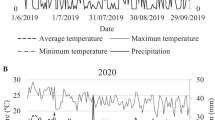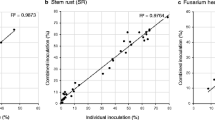Abstract
Latency period, infection frequency, lesion length, lesion growth, disease severity and percentage of infected leaf parts were assessed on 10-day-old seedling leaves and flag leaves of ten bread wheat (Triticum aestivum L.) cultivars after inoculation with urediospores of Puccinia striiformis Westend. f. sp. tritici. For all components significant genotypic differences were detected. Components of resistance tended to be associated. A long latency period was associated with a low infection frequency, small lesions, a low disease severity and a low percentage of infected leaf parts. The latency period, measured as time period until first pustule appearance (LP1), was highly correlated with the latency period measured as time period until 50% of the pustules appeared (LP50). Assessment of latency period of large numbers of cultivars could therefore be reliably done by measuring LP1 which is less time consuming than measuring LP50. Latency period, infection frequency and disease severity were highly correlated with disease development data from field experiments. These results suggest that selection in the greenhouse for one of these components should result in cultivars with high levels of quantitative resistance. Disease severity after uniform inoculation in the greenhouse can be used for monocyclic evaluations because it is the easiest to assess.
Similar content being viewed by others
References
Broers, L.H.M., 1989. Influence of development stage and host genotype on three components of partial resistance to leaf rust in spring wheat. Euphytica 44: 187–195.
Broers, L.H.M., 1993. Breeding for partial resistance in wheat to stripe rust. In: T. Jacobs & J.E. Parlevliet (Eds.), Durability of Disease Resistance, pp. 179–183. Kluwer Academic Publishers, Dordrecht, The Netherlands.
Broers, L.H.M., X. Cuesta Subía & R.M. López Atilano, 1996. Field assessment of quantitative resistance to yellow rust in ten spring bread wheat genotypes. Euphytica 90: 9–16.
Broers, L.H.M. & R.M. López Atilano, 1994. A method to inoculate adult wheat plants with urediospores of Puccinia striiformis to measure components of resistance. Plant Dis 78: 353–357.
Broers, L.H.M. & R.M. López Atilano, 1996. Effect of quantitative resistance in wheat on the development of Puccinia striiformis during early stages of infection. Plant Dis 80: 1265–1268.
Danial, D.L., 1993. Is partial resistance a suitable approach against stripe rust in wheat. In: T. Jacobs & J.E. Parlevliet (Eds.), Durability of disease resistance, pp. 185–189. Kluwer Academic Publishers, Dordrecht, The Netherlands.
Hyde, P.M. & S.A. Elahinia, 1989. The expression of adult-plant resistance in wheat to Puccinia striiformis. J Phytopathol 124: 31–38.
Hyde, P.M. & S.A. Elahinia, 1990. The expression of partial resistance to Puccinia striiformis in wheat. Effects on Colony growth and spore production. J Phytopathol 129: 203–209.
Johnson, D.A., 1986. Two components of slow-rusting in asparagus infected with Puccinia asparagi. Phytopathology 76: 208–211.
Johnson, R., 1981. Durable disease resistance. In: J.F. Jenkyn & R.T. Plumb (Eds.), Strategies for the Control of Cereal Disease, pp. 55–63.
Johnson, R., 1988. Durable resistance to yellow (stripe) rust in wheat and its implication in plant breeding. In: N.W. Simmonds & S. Rajaram (Eds.), Breeding Strategies for Resistance to the Rusts of Wheat, pp. 63–75. CIMMYT.
Johnson, R., R.W. Stubbs, E. Fuchs & N.H. Chamberlain, 1972. Nomenclature for physiological races of Puccinia striiformis infecting wheat. Trans Brit Mycol Soc 58: 475–480.
Kuhn, R.C., H.W. Ohm & G. Shaner, 1980. Inheritance of slow leaf-rusting resistance in Suwon 85 wheat. Crop Sci 20: 655–659.
Mares, D.J. & S. Cousen, 1977. The interaction of yellow rust (Puccinia striiformis) with winter wheat cultivars showing adult plant resistance: macroscopic and microscopic events associated with the resistant reaction. Physiol Plant Pathol 10: 257–274.
McNeal, F.H., C.F. Konzak, E.P. Smith, W.S. Tate & T.S. Russell, 1971. A uniform system for recording and processing cereal research data. ARS 34–121: 42 pp.
Milus, E.A. & R.F. Line, 1986. Number of genes controlling high-temperature adult plant resistance to stripe rust in wheat. Phytopathology 76: 93–96.
Ohm, H.W. & G.E. Shaner, 1976. Three components of slow leaf-rusting at different growth stages in wheat. Phytopathology 66: 1356–1360.
Park, R.F. & R.G. Rees, 1989. Expression of adult plant resistance and its effect on the development of Puccinia striiformis f.sp. tritici in some Australian wheat cultivars. Plant Pathol 38: 200–208.
Park, R.F., R.G. Rees & G.J. Platz, 1988. Some effects of stripe rust infection in wheat with adult plant resistance. Austr J Agric Res 39: 555–562.
Parlevliet, J.E., 1975. Partial resistance of barley to leaf rust, Puccinia hordei I Effect of cultivar and development stage on latent period. Euphytica 24: 21–27.
Parlevliet, J.E., 1979. Components of resistance that reduce the rate of epidemic development. Ann Rev Phytopathol 17: 203–222.
Parlevliet, J.E. & H.J. Kuiper, 1977. Partial resistance of barley to leaf rust, Puccinia hordei IV Effect of cultivar and development stage on infection frequency. Euphytica 26: 249–255.
Parlevliet, J.E. & A. van Ommeren, 1975. Partial resistance of barley to leaf rust, Puccinia hordei II Relationship between field trials, micro plot tests and latent period. Euphytica 24: 293–303.
Qayoum, A. & R.F. Line, 1985. High-temperature, adult-plant resistance to stripe rust of wheat. Phytopathology 75: 1121–1125.
Roebbelen, G. & E.L. Sharp, 1978. Mode of inheritance, interaction and application of genes conditioning resistance to yellow rust. Fortschritte der Pflanzenzüchtung 9: 88.
Sharma, Y.R., M.S. Kang & G.S. Bhullar, 1986. Evaluation of components of slow rusting in wheat varieties to yellow rust. Indian J Phytopathol 39: 221–224.
Sharp, E.L., 1968. Interaction of minor host genes and environment in conditioning resistance to stripe rust. In: 2nd European and Mediterranean Rusts Conference. pp. 158–159.
Sharp, E.L. & E. Fuchs, 1982. Additive genes in wheat for resistance to stripe (yellow) rust (Puccinia striiformis Westend.). Crop Protection 2: 181–189.
Sharp, E.L. & R.V. Volin, 1970. Additive genes in wheat conditioning resistance to stripe rust. Phytopathology 60: 1146–1147.
Stubbs, R.W., 1985. Stripe rust. In: A.P. Roelfs & W.R. Bushnell (Eds.), The Cereal Rusts II, pp.61–101. Academic Press. Zadoks, J.C., 1971. Systems analysis and the dynamics of epidemics. Phytopathology 61: 600–610.
Zadoks, J.C., T. Chang & C. Konzak, 1974. A decimal code for the growth stages of cereals. Weed Res 14: 415–421.
Author information
Authors and Affiliations
Rights and permissions
About this article
Cite this article
Broers, L. Components of quantitative resistance to yellow rust in ten spring bread wheat cultivars and their relations with field assessments. Euphytica 96, 215–223 (1997). https://doi.org/10.1023/A:1002916110347
Issue Date:
DOI: https://doi.org/10.1023/A:1002916110347




